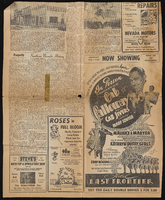Search the Special Collections and Archives Portal
Search Results
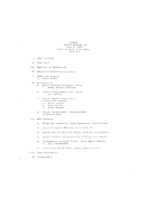
Meeting minutes for Consolidated Student Senate, University of Nevada, Las Vegas, June 6, 1978
Date
1978-06-06
Archival Collection
Description
Agenda and meeting minutes for the University of Nevada, Las Vegas Student Senate.
Text
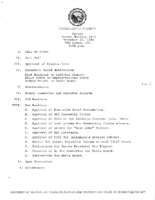
Meeting minutes for Consolidated Student Senate University of Nevada, Las Vegas, November 21, 1985
Date
1985-11-21
Archival Collection
Description
Includes meeting agenda and minutes along with additional information about the memorandum. CSUN Session 16 (Part 1) Meeting Minutes and Agendas.
Text
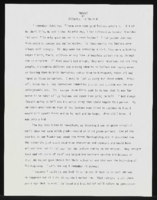
"Thanks": article draft by Roosevelt Fitzgerald
Date
1980 (year approximate) to 1995 (year approximate)
Archival Collection
Description
From the Roosevelt Fitzgerald Professional Papers (MS-01082) -- Drafts for the Las Vegas Sentinel Voice file. On the Thanksgiving holiday.
Text

Transcript of interview with Gus Mancuso by Lisa Gioia-Acres, September 27, 2008
Date
2008-09-27
Archival Collection
Description
Gus Mancuso (Ronald Bernard Mancuso), a talented impresario, was born in Spangler, Pennsylvania in 1933. Gus grew up in Hastings, Pennsylvania as the youngest of nine children. His father, an immigrant from Italy, Joseph Mancuso, owned multiple businesses and his mother, Josephine Ceranni toiled as a stay at home mother. Despite his father’s businesses, the family struggled financially. By the eighth grade Gus moved to Rochester, New York, where his mother joined him, after his parents separated. As a youngster Gus Mancuso learned to play the trumpet by ear. By age 11 he was encouraged to learn to play the drums so he could help earn money for the family. After two weeks of training, Gus Mancuso was earning $5 dollars as the replacement for his older brother Joe in musical performances in places like Moose Hall and the Elks Club in Pennsylvania. His performances were so legendary that an article was written about Gus entitled the “Eighth Grade Drummer”. He continued to demonstrate tremendous musical versatility even after moving from Hastings to Rochester where he received first chair trombone honors after impressing his high school band teacher. After graduating high school, in 1951, Gus went on the road with the Don Manning Trio. Shortly thereafter, a bass player position opened in his brother’s group the Ray Brand Trio. Despite the fact that Gus did not know how to play bass, when he received the offer to become a member of Joe’s band, he went on to learn yet another instrument and joined the Ray Brand Trio. However, while with his brother’s group, Gus was drafted into the army. He packed his trumpet, and despite initially receiving flack for playing in the latrine, the lieutenant exempted Gus from duty so he could perform in the morning and at night for his fellow troops. Shortly thereafter, Gus served in the army band as a piano player. His instrumental capabilities and proficiency helped pave the way for more opportunities. After the army he moved to Nevada and played trombone with Tony Pastor in Reno. He found his way to Las Vegas in 1955 when he opened at the New Frontier on Halloween night. Gus went on to open at Caesars Palace in Las Vegas, playing bass, with Sarah Vaughn. They went on to tour Europe together. He also played bass for Billy Eckstine and Les Brown as well as worked in the music department at the University of Nevada, Las Vegas. Gus Mancuso met Lauri Perri, a singer and his first wife, while playing for the Mary Kaye Trio in Lake Tahoe. They were married at the Little Church of the West in 1960. However, Gus is now married to Maggie Peterson an actress who worked on the Andy Griffith Show. He lives in Las Vegas and currently works three nights a week playing piano at the Bootlegger owned by his first wife and getting the job from his son Ronald.
Text
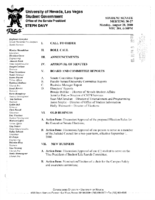
Meeting minutes for Consolidated Student Senate, University of Nevada, Las Vegas, August 28, 2000
Date
2000-08-28
Archival Collection
Description
Includes meeting minutes and agenda, along with additional information about a performance contract and program.
Text
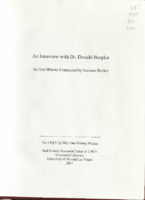
Transcript of interview with Dr. Donald Baepler by Suzanne Becker, April 23, 2007
Date
2007-04-23
Archival Collection
Description
Dr. Donald Baepler was born in Edmonton, Alberta, Canada in July of 1932. The family moved to Springfield, Illinois in 1936, where his father was president of Concordia Seminary. Donald decided at the age of seven that he wanted to pursue a Ph.D. in ornithology, not an unusual goal in his family. By the time he graduated high school, he knew that he wanted to attend Carlton College in Minnesota to study under Olin Sewall Pettingill. He followed world-famous ornithologist and artist George Sutton to Michigan and then to Oklahoma to complete his doctorate. In 1960, having completed his doctorate, Donald met with a recruiter from Las Vegas. It seemed like an intriguing place, so he took the interview and was offered a job on the spot. Instead, he took a job as professor of biology at Central Washington University, and within four years was vice president for administration and business. He had also been appointed to an accrediting team by the Northwest Association to accredit colleges in the western states, including Nevada Southern University in Las Vegas, and saw the growing town and university for the first time in 1965. Two years later, he was invited to take the job of Academic Vice President at SNU, which he accepted, and he and his family made the move to Las Vegas in 1968. Upon arriving in Las Vegas, Donald discovered that he had been named acting president because of Donald Moyer's abrupt resignation. He simply decided to do both jobs. He was successful in changing the name of the school to University of Nevada Las Vegas so that it would not be confused with a teacher's college. This was wholeheartedly accepted by the regents. Once Roman Zom was appointed president in 1969, Donald went back to the vice president position. In 1973, Dr. Baepler was appointed president of UNLV. He held that position for live years and then turned in his resignation. His intent was to teach, focus on a Museum of Natural History, and start a research center. Instead, he was offered the chancellorship of the university system, and he decided to accept the job By 1981, Donald was ready to return to teaching and research, so he resigned as chancellor and came back full-time as museum director and professor of biology. He built up a high-hazard chemistry lab and got the grant monies to sustain it. Dr. Baepler was also influential in adding the Harry Reid Center to the museum. Today Dr. Baepler is still involved with the bird program and gives advice to graduate students, but he no longer teaches. He stays occupied with a private consulting business.
Text
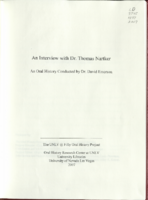
Transcript of interview with Dr. Thomas Nartker by Dr. David Emerson, November 13, 2006
Date
2006-11-13
Archival Collection
Description
Thomas Nartker was born and raised in Dayton, Ohio, and most of his family, including three brothers and a sister, still live there. He attended grade school and high school there, and then attended the University of Dayton. He majored in chemical engineering, following the example of his father, who had a degree in electrical engineering. By the time he was a sophomore in college, he was six-foot nine and had spent some time on the basketball court, but when asked to play his senior year at U. of D., he declined. He had already been accepted for graduate study at the University of Tennessee. Thomas finished all course work and research on his master's in one year, everything but the thesis. He interviewed over 30 companies before he graduated, but an interview with DuPont in Delaware made him think about the value of a PhD in his line of work. He applied and was accepted at Texas A&M. He worked with Dave Billingsley, who was the resident computer expert, and Dave showed him how to process all the data he had collected for his master's thesis on the IBM 650. Tom had found a new passion. Within a year, Tom was working as an assistant in the data processing center at Texas A&M, and was also the teaching assistant for the computer programming class. After completing his PhD, which took 6 years, Thomas began interviewing again. He accepted a position at New Mexico Institute of Mining and Technology (NMIMT) as assistant professor of mathematics and director of the computing center. He left NMIMT in 1981 and took a job with Shell Oil Company, which included 5 years as a visiting staff member at Los Alamos. In 1985 he met John Werth, who ultimately offered Tom a job at UNLV. Tom made the move to Las Vegas in July of 1985. Dr. Nartket and Dr. Taghva started the UNLV Information Science Research Institute and did experimental research on Optical Character Recognition (OCR) for the Department of Energy (DOE). They invented many metrics never seen before, including a metric called Nonstop Word Accuracy. Today UNLV is known worldwide for being the premier center for doing research in OCR technology. Thomas is in his seventies today and continues with his research and teaching because he loves it. He has enjoyed over two decades at UNLV and finds it a rewarding and intellectual place to be. He considers this university to be one of the most exciting in the country as it grows in research and service.
Text
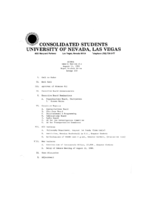
Meeting minutes for Consolidated Student Senate, University of Nevada, Las Vegas, August 12, 1980
Date
1980-08-12
Archival Collection
Description
Includes meeting agenda and minutes. CSUN Session 10 Meeting Minutes and Agendas.
Text
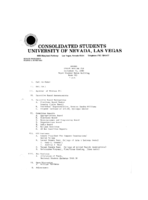
Meeting minutes for Consolidated Student Senate, University of Nevada, Las Vegas, September 23, 1980
Date
1980-09-23
Archival Collection
Description
Includes meeting agenda and minutes. CSUN Session 10 Meeting Minutes and Agendas.
Text
Pagination
Refine my results
Content Type
Creator or Contributor
Subject
Archival Collection
Digital Project
Resource Type
Year
Material Type
Place
Language
Records Classification

